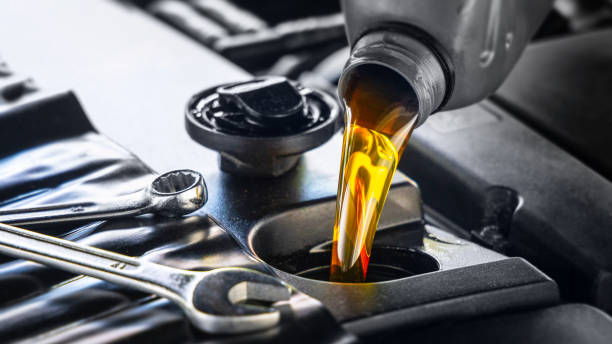
How Often Should You Change Your Car Oil?
Keeping your car’s engine running smoothly isn’t just about filling the tank, it’s about keeping the oil clean, fresh, and doing its job. Oil changes are one of the simplest and most effective ways to extend the life of your vehicle. Yet, many drivers delay this basic maintenance, not realizing how quickly dirty or old oil can harm engine components. Fresh oil reduces friction, keeps parts cool, and prevents wear that can lead to expensive repairs. Ignoring oil maintenance can cause poor performance, reduced fuel economy, and even engine failure. Understanding how often you should change your car’s oil helps protect your investment, ensures smoother rides, and saves you money over time.
Why Is a Regular Oil Change So Important for Your Engine?
Changing your car’s oil on time keeps your engine clean, cool, and protected from wear. Over time, oil collects dirt and loses its ability to lubricate properly. Replacing it regularly prevents friction damage and helps your engine perform efficiently for years.
What Role Does Oil Play in Protecting Your Engine?
Motor oil acts as the lifeblood of your vehicle’s engine. It lubricates metal components, minimizes friction, and prevents overheating while your engine runs thousands of revolutions per minute. Beyond lubrication, oil also helps clean the engine by carrying away dirt, carbon deposits, and metal shavings to the oil filter. Without proper oil flow, these contaminants can build up, leading to corrosion, sludge, and premature wear on pistons and valves. Simply put, oil keeps the engine cool, clean, and running efficiently. That’s why maintaining the right oil level and condition is essential for the long-term health of any vehicle, regardless of make or model.
What Happens Inside Your Engine When Oil Gets Old?
Over time, engine oil loses its viscosity, meaning it becomes thinner and less effective at protecting moving parts. Heat, oxidation, and contaminants from fuel combustion gradually break down the oil’s protective properties. When this happens, friction increases inside the engine, causing metal surfaces to rub directly against each other.
You might notice signs such as louder engine noise, rough idling, or sluggish acceleration. Old oil also turns darker and thicker, making it harder to circulate. If left unchanged, this can cause engine overheating or permanent internal damage. Regular oil changes prevent these issues by ensuring the engine always runs with clean, high-quality oil that can handle the stress of daily driving.
How Oil Changes Help Extend Vehicle Life and Performance
Routine oil changes do more than just prevent breakdowns; they improve your car’s overall performance and efficiency. Clean oil allows the engine to run with less resistance, improving fuel economy and reducing emissions. A well-lubricated engine also delivers smoother acceleration and quieter operation. For newer cars with advanced sensors and turbocharged engines, clean oil helps maintain proper pressure and ensures components like timing chains and turbos perform correctly. Over the long term, consistent oil maintenance helps prevent major mechanical failures, keeping your car reliable for years to come. That’s why many professional technicians say oil changes are the best investment for long-term vehicle health.
How Often Should You Really Change Your Car Oil?
Most modern vehicles need oil changes every 5,000 to 7,500 miles, though some can go longer with synthetic oil. Your exact interval depends on driving habits, oil type, and manufacturer recommendations. Sticking to the proper schedule keeps your engine healthy and avoids costly repairs.
What’s the Recommended Oil Change Interval for Most Cars?
For many years, drivers followed the “every 3,000 miles” rule, but modern engines and improved oil technology have changed that. Today, most vehicles can safely go between 5,000 to 7,500 miles between oil changes, and some synthetic oils last up to 10,000 miles. However, these numbers vary depending on the vehicle’s age, engine type, and the oil used. Always refer to your owner’s manual for the manufacturer’s recommendation. For instance, smaller turbo engines or high-performance cars may require more frequent oil changes to stay protected. Sticking to the proper schedule ensures your engine runs efficiently without over-servicing or neglecting it.
How Does Driving Style Affect Oil Change Frequency?
Your driving habits play a major role in how quickly your oil wears out. Frequent short trips, stop-and-go traffic, or idling for long periods prevent the oil from reaching its optimal operating temperature, causing moisture and contaminants to build up faster. On the other hand, long highway drives allow the oil to circulate and stay cleaner for longer. Aggressive driving, heavy towing, and driving in dusty or sandy conditions can also degrade oil more quickly. So, if your daily routine involves tough conditions, it’s smart to change oil more often than the standard mileage interval. Adapting your oil change schedule to your lifestyle helps maintain peak performance.
Does Synthetic Oil Last Longer Than Conventional Oil?
Yes, synthetic oil is engineered to last longer and perform better under extreme temperatures. It resists breakdown, maintains viscosity, and provides better protection for modern engines. Synthetic oils can often last up to twice as long as conventional oils while improving fuel efficiency and reducing deposits inside the engine. They are ideal for newer vehicles, high-performance engines, and drivers who frequently face temperature swings or long commutes. While synthetic oil may cost more upfront, it often saves money over time by reducing maintenance frequency and preventing wear-related damage. Many automakers now recommend synthetic oil exclusively because of its proven reliability.
Should You Follow the Manufacturer’s Maintenance Schedule?
Absolutely. The manufacturer’s maintenance schedule is based on extensive testing specific to your engine design. It outlines how often you should change oil under both “normal” and “severe” driving conditions. Following this schedule ensures your car remains under warranty and performs as intended. Skipping or delaying oil changes can void warranty coverage or cause internal engine wear that isn’t covered by insurance. Most vehicles now include maintenance reminders or oil life monitoring systems that track driving patterns and recommend service intervals accordingly. Trust those systems, and when in doubt, ask a certified mechanic to help you set the right schedule for your car.
What’s the Difference Between “Normal” and “Severe” Oil Change Schedules?
Your oil change frequency depends on how and where you drive. “Normal” schedules fit highway drivers and mild conditions, while “severe” schedules apply to stop-and-go traffic, short trips, or extreme temperatures. Knowing which fits your driving helps maintain your car’s best performance.
What Qualifies as Normal Driving Conditions?
“Normal” driving conditions apply when your car operates in moderate temperatures, smooth traffic flow, and balanced driving habits. This means mostly highway driving, minimal idling, and regular oil circulation that keeps contaminants from building up. Under these conditions, oil remains cleaner for longer, so you can safely extend your oil change interval to the manufacturer’s maximum recommendation. Most vehicles in suburban or rural areas with steady-speed driving fall into this category. However, it’s important to regularly check oil color and level, even under normal use, to ensure the system is functioning as expected.
What Makes a Vehicle Fall Under the Severe Service Category?
Vehicles driven under “severe” conditions experience much higher stress on their engines and oil systems. This includes frequent short trips (less than 5 miles), stop-and-go urban traffic, towing heavy loads, driving in extreme temperatures, or operating in dusty or sandy environments. Under these circumstances, oil breaks down faster and absorbs more contaminants. Drivers in cities like Torrance and San Pedro often fall under this category due to constant traffic and short-distance commutes. In these cases, experts recommend changing oil every 3,000 to 5,000 miles to maintain proper lubrication and engine protection.
How Can You Tell Which Schedule Applies to You?
The easiest way to determine your category is by analyzing your driving routine. If most of your trips involve steady highway speeds and moderate climates, you’re likely under the normal schedule. However, if your driving includes short errands, heavy loads, or long periods of idling, consider yourself in the severe category. Another factor is the age of your vehicle, older engines tend to burn oil faster and may require more frequent changes. Consulting with a certified mechanic can help clarify which maintenance schedule fits your lifestyle best. Keeping track of mileage, trip types, and oil condition helps you make informed decisions about your vehicle’s needs.
What Are the Signs That It’s Time for an Oil Change?
Warning lights, darker oil, or a louder engine are clear signs it’s time for fresh oil. You may also notice rough idling or reduced fuel economy. Checking your oil regularly helps you spot these symptoms early and prevent engine damage.
Does the Check Engine or Oil Light Mean It’s Time?
Yes, if your oil pressure or maintenance light comes on, it’s a clear warning that your oil level or quality is low. The oil change indicator doesn’t mean your engine is failing yet, but it’s signaling that the oil has lost its ability to properly lubricate. Ignoring it can lead to increased friction, overheating, or serious mechanical damage. It’s best to schedule an oil change as soon as the light appears rather than waiting for performance issues. Many vehicles now use sensors to measure oil condition, so the light reflects actual oil degradation rather than just mileage intervals.
Why Does Your Car’s Engine Sound Louder or Rougher?
When engine oil becomes old or thin, it can no longer create a smooth barrier between moving parts. This increases friction, leading to ticking, knocking, or grinding noises under the hood. You may also feel vibrations or reduced smoothness while idling. A louder or harsher sound often indicates that your engine components are not being properly lubricated. Ignoring these sounds can cause irreversible damage over time, especially to bearings and valves. Replacing the oil promptly can restore quiet, smooth operation and protect your engine from long-term harm.
How Can You Check Oil Color, Smell, and Level?
Checking your oil manually is simple and effective. Pull out the dipstick, wipe it clean, reinsert it, and check the oil’s level and color. Fresh oil should appear amber or golden and feel smooth between your fingers. If it looks dark brown or black, smells burnt, or feels gritty, it’s overdue for a change. Additionally, if the oil level is below the minimum mark, top it off or schedule service immediately. Performing this check once a month helps you stay ahead of potential problems and ensures your engine stays healthy between oil changes.
What Happens If You Wait Too Long to Change Your Oil?
Delaying oil changes can cause significant damage to your engine. As oil deteriorates, it becomes thick with sludge and contaminants that restrict circulation. This forces the engine to work harder, increasing fuel consumption and internal wear. In severe cases, lack of lubrication can lead to overheating, warped pistons, or even total engine failure. Once oil has broken down completely, no additive or quick fix can restore its protective properties. The cost of neglecting oil maintenance far outweighs the price of routine service. Timely oil changes keep your engine running efficiently, ensuring safety and reliability every time you drive.
What’s the Difference Between Synthetic and Conventional Oil?
Choosing between synthetic and conventional oil is one of the most common decisions drivers face during maintenance. Both serve the same purpose, lubricating and protecting the engine, but they differ in performance, lifespan, and cost. Synthetic oil is engineered with uniform molecules that resist breakdown, perform better under heat, and flow more efficiently in cold temperatures. Conventional oil, on the other hand, is refined from crude oil and tends to degrade faster. Understanding these differences helps you choose the right oil for your driving habits, vehicle type, and climate conditions.
Which Type of Oil Lasts Longer?
Synthetic oil clearly outperforms conventional oil in terms of longevity. While traditional oil typically lasts around 3,000 to 5,000 miles, synthetic blends can extend intervals up to 7,500 to 10,000 miles, sometimes more with advanced formulations. The reason is simple: synthetic oil resists oxidation, sludge buildup, and viscosity loss far better. It also provides consistent protection in both high and low temperatures. Drivers who frequently travel long distances, tow heavy loads, or drive in extreme weather benefit most from the extended lifespan of synthetic oil. Though it costs slightly more, it pays off by reducing the number of oil changes needed throughout the year.
Is Synthetic Oil Better for Modern Engines?
Yes, synthetic oil is generally better for modern vehicles, especially those with turbocharged or direct-injection engines. These engines operate under higher pressure and temperature, which demands oil that can handle stress without breaking down. Synthetic oils are formulated with advanced detergents and friction modifiers that help reduce deposits and maintain clean internal components. They also improve cold-start protection, meaning your engine gets lubricated faster during ignition. Many car manufacturers now recommend or even require synthetic oil for newer models because it provides the best balance between performance, efficiency, and protection.
Can You Switch Between Synthetic and Conventional Oil?
Yes, you can safely switch between synthetic and conventional oil without damaging your engine. Modern oils are fully compatible, and blending them doesn’t cause harm. However, once you experience the benefits of synthetic oil, longer life, better performance, and cleaner operation, it’s usually best to stick with it. Switching back to conventional oil may reduce those advantages, especially in vehicles that run under high strain or variable conditions. Always make sure the oil meets the viscosity grade and API certification specified in your owner’s manual before making any change.
Should You Change the Oil Filter Every Time You Change Oil?
What Does the Oil Filter Do?
The oil filter plays a critical role in keeping your engine clean by trapping dirt, debris, and tiny metal particles that build up in the oil. As the oil circulates through the engine, it passes through this filter before being redistributed. A good filter ensures contaminants don’t reach sensitive components like pistons, bearings, or camshafts. Over time, though, filters become clogged, reducing oil flow and increasing engine wear. Without an effective filter, even fresh oil can’t fully protect the engine, which is why the filter’s condition is just as important as the oil itself.
Why Skipping Filter Replacement Is a Common Mistake
Many drivers assume the oil filter can last through multiple oil changes, but that’s a costly misconception. As filters trap more contaminants, they gradually lose efficiency. Continuing to use a clogged filter means the oil can’t circulate freely, forcing your engine to work harder and run hotter. This leads to faster oil breakdown and reduced lubrication. Replacing the oil but not the filter is like putting clean water through a dirty sponge, it defeats the purpose. Replacing the filter with each oil change guarantees your fresh oil stays clean and effective for the full interval.
How Often Should You Replace the Oil Filter?
Most experts recommend replacing the oil filter every time you change your oil, typically every 5,000 to 7,500 miles, depending on your vehicle and oil type. For vehicles using synthetic oil with longer service intervals, use a high-capacity filter designed to handle extended mileage. If you frequently drive in dusty areas or make short trips, it’s better to replace the filter more often. Quality filters from trusted brands, or OEM filters used at professional shops like Torrance Motors – ensure consistent oil flow and maximum protection for your engine between services.
Can You Trust Your Car’s Oil Life Monitoring System?
Modern vehicles use sensors to estimate oil health, but these systems aren’t perfect. They track driving conditions and mileage, but can’t detect contamination. Always double-check oil levels manually to ensure your engine stays properly protected.
How Do Modern Oil Life Systems Calculate Change Intervals?
Modern vehicles use oil life monitoring systems that rely on data from sensors and algorithms to estimate oil condition. These systems track variables such as engine temperature, RPM, trip length, and mileage rather than relying solely on a set number of miles. When the system detects oil degradation or excessive heat cycles, it alerts the driver with a “Change Oil Soon” message. This technology helps extend intervals safely, reducing unnecessary service visits. However, it’s still a predictive system; it doesn’t analyze the actual oil composition, so it’s wise to use it as a guide, not a guarantee.
Why You Should Still Double-Check Your Oil Manually
Even with advanced monitoring systems, manually checking your oil remains the best way to know its true condition. Sensors can’t always detect contamination from dirt or coolant leaks, and extreme conditions can degrade oil faster than the system predicts. By checking the dipstick once a month, you can observe the oil’s color, consistency, and smell. If it appears dark, thick, or burnt, it’s time for a change, regardless of what your dashboard says. A quick manual check adds an extra layer of assurance that your engine remains fully protected.
When to Ignore the System and Change Oil Sooner
There are situations where you should change your oil earlier than the system recommends. If you’ve been towing heavy loads, driving in stop-and-go traffic, or operating in dusty or hot environments, your oil is under more stress. Similarly, if your oil looks dirty or the engine feels rough, don’t wait for the alert, get it changed. Technology is helpful, but human observation is key to long-term vehicle health. Mechanics at Torrance Motors can also reset your oil life monitor and advise you on a personalized schedule based on your driving patterns.
How to Get the Most Out of Every Oil Change
Choosing the right oil, changing it on schedule, and replacing the filter ensures your car runs smoothly. Combine oil service with inspections or tire rotations to keep your vehicle in top condition and save on long-term maintenance.
What Type of Oil Is Best for Your Vehicle and Climate?
The best oil for your vehicle depends on your manufacturer’s recommendation and your local driving environment. For example, drivers in cooler areas benefit from lower-viscosity oil that flows easily in cold starts, while those in warmer regions like Torrance or San Pedro may prefer oil with higher heat resistance. Synthetic oils offer better all-season performance, but high-mileage formulas are ideal for older engines prone to oil leaks. Always check your owner’s manual or ask a trusted technician for advice on the right viscosity and formulation for your engine’s needs.
How Professional Oil Changes Save You Time and Hassle
While some drivers prefer DIY oil changes, having a professional handle it ensures everything is done correctly and safely. Certified technicians don’t just replace oil, they inspect gaskets, belts, filters, and fluid levels during the service. They also dispose of used oil properly, protecting both your vehicle and the environment. At Torrance Motors, professional oil change services include a full safety inspection, ensuring your car leaves the shop in top condition. This expert attention saves you time, reduces mistakes, and gives you peace of mind knowing your engine is properly maintained.
What Other Maintenance Should You Combine with an Oil Change?
An oil change is the perfect time to take care of other essential maintenance tasks. Mechanics often recommend checking or replacing the air filter, cabin filter, wiper blades, and fluid levels during the same visit. Tire rotation and brake inspections also pair well with oil service since these tasks help maintain balanced wear and safe handling. Combining services saves time and ensures your vehicle runs efficiently. Many repair shops, including Torrance Motors, offer maintenance packages that include these add-ons to keep your vehicle running strong throughout the year.
When Should You Visit Torrance Motors for an Oil Change?
If your oil light is on, your engine sounds louder, or it’s been months since your last service, it’s time to visit Torrance Motors. Our certified technicians use high-quality oil and filters to keep your car performing like new.
What Makes Torrance Motors Trusted by Local Drivers?
Drivers in Torrance and San Pedro trust Torrance Motors for honest, high-quality service backed by years of experience. Our ASE-certified technicians understand every detail of modern vehicles and use top-grade oil and filters that meet or exceed manufacturer standards. We prioritize transparency, explaining every step of the process so you know exactly what your car needs. Whether you drive a compact sedan, SUV, or performance car, our shop is equipped to handle it with precision and care.
Do You Use High-Quality Oils and Certified Filters?
Yes, Torrance Motors only uses premium synthetic, semi-synthetic, and conventional oils approved by major automakers. Every oil change includes a certified oil filter replacement, ensuring full protection for your engine. Using high-quality materials guarantees better lubrication, cleaner operation, and improved longevity. Our technicians match oil type and viscosity to your car’s exact requirements, ensuring it performs at its best between services. We never cut corners; your engine’s health and safety are always our top priority.
How Can Customers Schedule a Quick Oil Change Appointment?
Scheduling an oil change at Torrance Motors is simple and convenient. You can book online, call our service center, or visit our Torrance or San Pedro locations for same-day appointments. We offer fast service without compromising quality, so most oil changes are completed in under an hour. Our goal is to get you back on the road quickly with the confidence that your engine is running at peak condition. Regular oil maintenance is an easy step, and with Torrance Motors, it’s always a smooth one.
Conclusion: Keep Your Engine Running Strong
Regular oil changes are the foundation of a healthy, long-lasting vehicle. They protect against wear, improve performance, and save you from costly repairs. Whether your car uses synthetic or conventional oil, following the proper schedule and trusting certified technicians makes all the difference. Ignoring oil maintenance can shorten your engine’s lifespan, while consistent care keeps it performing like new.
Schedule your next oil change at Torrance Motors: trusted by Torrance and San Pedro drivers for expert service, high-quality products, and honest automotive care.


